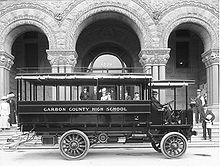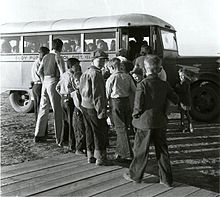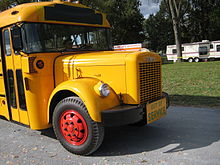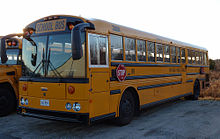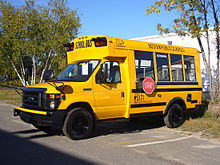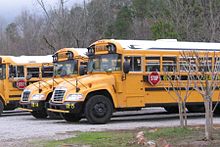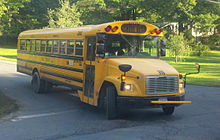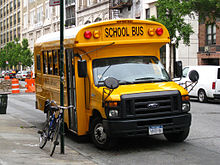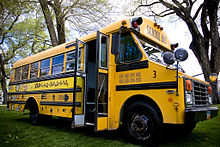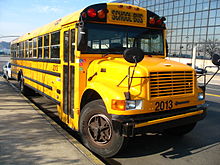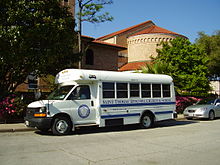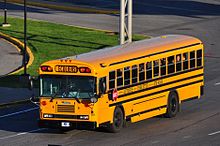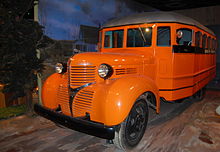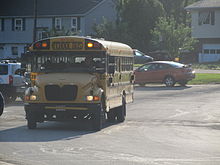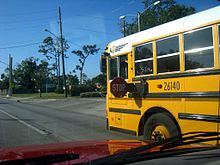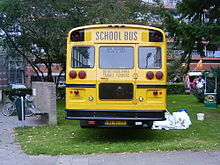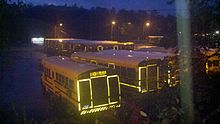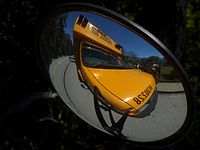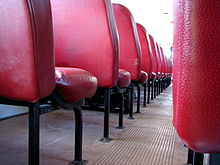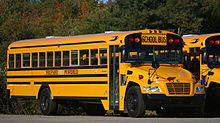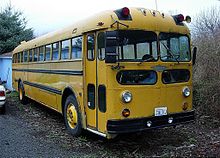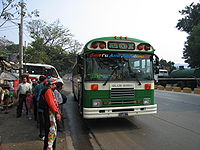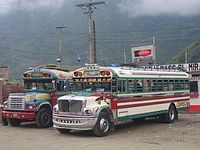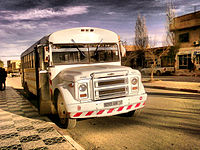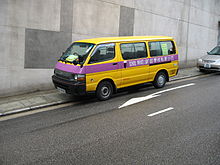- School bus
-
This article is about vehicles specifically designed and manufactured for carrying students to and from school. For information about school transportation in general, see student transport.
School Bus 
Front 3/4 view of a typical North American school bus
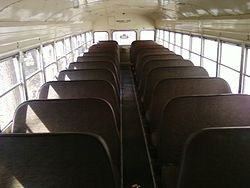
Interior view of an empty school busManufacturer List of school bus manufacturers Capacity 10-90 passengers, depending on model Operator(s) school districts, school bus contractors Specifications Length Up to 45 feet (14 m) Width Up to 102 inches (2,600 mm) Doors Front entry/exit door; rear emergency exit door Weight ≤10,000–36,000 pounds (4,500–16,000 kg) (GVWR) Options Along with individual customer options, various specifications required by individual U.S. states/Canadian provinces A school bus is a type of bus designed and manufactured for student transport: carrying children and teenagers to and from school and school events. The first school bus was horse-drawn, introduced in 1827 by George Shillibeer for Newington Academy for Girls, a Quaker school in Stoke Newington, north-east of London (UK), and was designed to carry 25 children.[1]
The primary vehicle used for student transport in North America, school buses are distinguished from other types of buses by design characteristics necessitated by federal and state/provincial regulations. Federal safety standards require school buses to be painted school bus yellow and equipped with specific warning and safety devices.[2] This service is almost always provided without charge to families. In the U.S., the term "busing" is also a term that refers to desegregation busing, the transport of students to schools other than the closest local school for the purposes of racial integration. In other parts of the world, the term "school bus" refers more to the destination of the bus and its student passengers than the specific vehicle designed for that purpose; the vehicles used for student transport are more closely related to other types of buses than their North American counterparts.
In the United States, school buses provide an estimated 10 billion student trips every year. Every school day, over 480,000 school buses transport 26 million children to and from schools and school-related activities; over half of the country's student population is transported by school bus.[3] School buses are leased or purchased by school districts, while other school districts use school bus contractors to transport students. In the United States, approximately 40% of school districts use contractors to handle student transportation; in Canada, they are used almost universally.[citation needed]
Design history (North America)
Early versions (19th century-1930)
Kid hacks
Wayne Works, predecessor of Wayne Corporation, was founded in the United States in 1837. By the mid-1880s, it is known that the company manufactured horse-drawn school carriages colloquially referred to as "school hacks", "school cars", "school trucks", or "kid hacks". ("hack" was a term for certain types of horse-drawn carriages.)[4]
Initial "horseless" school buses retained the rear entry of the kid hacks (a feature designed as to not startle the horses when loading or unloading passengers). Inside, many kid hacks and early school buses had perimeter seating with benches mounted to the outside walls of the vehicle. Early school buses served predominately rural areas where it was deemed impractical for students to walk the distances necessary to get back and forth from school on their own. Like the kid hacks, they were essentially no more than a truck with a tarpaulin stretched over the truck bed.
Enclosed school buses
Wayne Works was one of the first manufacturers to offer glass windows in place of roll-up canvas curtains in the passenger compartment in the early 1920s,[4] although Gillig Bros had invented and patented the design long before. Known as the "California top", Gillig's design featured a slightly curved reinforced metal roof, with windows separated by pillars at regular intervals, and each window was adjustable by the use of a latching mechanism.[5] Other manufacturers continued using curtains until the 1930s.[6] Wayne began manufacturing its first model of all-steel body school buses in 1930.[4] Crown Coach followed in 1932 with its steel-bodied transit-style Crown Supercoach. The Supercoach was the highest-capacity school bus at the time, seating 76 passengers.[7][8]
Industry standardization (1930-1945)
The 1930s were a decade where the school bus evolved from an adaptation of existing vehicles (wagons, carriages, trucks) into a vehicle type of its own. The "California top" introduced by Gillig was quickly adopted industry-wide.[5] As it was becoming popular in other places in the automotive industry, all-metal body construction became featured by manufacturers as the decade progressed.
Enabling mass production
The custom-built nature of school buses created an obstacle to their profitable mass production on a large scale. Although school buses had begun to evolve from wagons, there was not yet an agreed upon set of industry-wide standards for school buses. A 1939 conference organized by rural education expert Dr. Frank W. Cyr forever changed the design and production of school buses; it was attended by transportation officials, representatives from body and chassis manufacturers, and paint companies.[9] The conference resulted in a set of 44 standards adopted by all manufacturers (interior dimensions, seating configuration). Many of those standards allowed for consistency among body manufacturers, reducing the complexity of production as well as the price of their products; large-scale production was now possible.
School Bus Yellow
Other standards at Dr. Cyr's 1939 conference also applied to improving school bus safety. The most recognizable standard was the development of school bus yellow as a standardized school bus color; the attendees considered yellow the easiest to see in dawn and dusk, and it contrasted well with black lettering.[9] Yellow is now the shade associated with school buses worldwide[by whom?]; officially it is known as National School Bus Glossy Yellow in the United States,[2] and Chrome Yellow in some parts of Canada.[10] Although it is not a government specification outside of the United States and Canada, school buses outside North America often feature some shade of yellow in part or in whole.[11]
Post-war growth (1945-1980)
Following World War II, the baby boom resulted in rapid growth in both urban and suburban areas, initially outpacing school construction. This led to an increase in the demand for school buses in both cities and suburbs as well as rural areas.
As the school bus evolved from a primarily rural form of transportation to something used in both urban and suburban population centers, two new variants emerged. Transit-style school buses had increased capabilities (seating capacity, handling) over conventional-style school buses. Small school buses were developed for the transportation of special-needs students and for routes unsuitable for larger buses. However, conventional-type school buses on a truck chassis still proved popular among the majority of operators in the decades to come.
Transit-style school buses
In the 1930s, Crown Coach, Gillig Bros., Wayne Works, and other school bus manufacturers produced some buses with a relatively flat front-end design;[8] this was influenced by buses used mass-transit as well as motorcoaches. In present-day nomenclature, they are known as "Type D" school buses. Crown Coach built the first heavy duty, high capacity, transit-style school coach in 1932 and named it the "Supercoach", as many California school districts operated in terrain requiring heavy-duty vehicles.[8] In 1948, Albert L. Luce, founder of the Blue Bird Body Company, developed a transit-style design which evolved into the company's All American. In 1959, Gillig Bros. introduced the rear-engine diesel-powered school bus; soon afterwards, the Gillig Transit Coach School Bus became the most popular example of the type on the West Coast.[12]
Although the design first appeared in 1932, it became more commonly used after World War II.[8] A factor in the rapid rise of school bus sales in the 1950s (especially on the West Coast) was the baby boomers' entry into school. Faced with a rapid rise in student counts, school districts were forced to consolidate, buy larger school buses, or both. Transit-style school buses offered a solution, as their higher capacities (up to 97 passengers) meant that fewer buses needed to be driven and maintained, offsetting their higher initial purchase price. As a result, the use of the transit-style school bus increased during the mid-1950s. However, the conventional or "Type C" design with a truck-type chassis would still dominate U.S. school bus manufacturing into the 21st century.
Small school buses
In the early 1960s, conventional-type school buses gained increased capabilities as their manufacturers switched the source of donor chassis from pickup trucks to medium-duty trucks. Although the heavier-duty components allowed for much larger buses, certain urban neighborhoods could not accommodate full-size buses. Initially, conversions of vans and SUVs into minibuses filled the role of small school buses. In 1967, the first dedicated small school bus was introduced by Collins Bus,[13] followed by the Wayne Busette in 1973. Along with van-based vehicles (known as "Type A" school buses), the industry also developed several heavier-duty products that used the chassis of a delivery van or "step-van" (known as "Type B" buses); the best known of these is the Blue Bird Mini Bird, produced from 1977-2005.
Although small school buses are also used for magnet school programs, transporting exceptionally talented and gifted students, and for routes with low volumes of riders, they are also associated in urban slang with mentally disabled riders. This association has given them derogatory nicknames, such as "the short bus".[14][15] For the transportation of special-needs students, these buses are often equipped with automated lifts for wheelchair-bound passengers unable to climb steps into the bus. In addition to the driver, these buses often have attendants or aides on board to deal with physical or mental issues of student passengers.
Other changes
In 1977, the federal government brought into effect a number of safety regulations that changed the design and construction of school buses. Most visibly, these standards —known as Federal Motor Vehicle Safety Standards for School Buses[16]— mandated taller seats as well as thick padding on the front and back. Under the sheetmetal, school buses were now required to be built stronger for improved crashworthiness.
In 2002, NHTSA published a report to Congress that highlighted the safety of school buses. NHTSA's Research and Development Office said that U.S. students are eight times safer riding in a school bus than with their own parents or guardians in cars. NHTSA also stated that the fatality rate for school bus passengers is 0.2 deaths per 100 million vehicle miles traveled, compared to 1.5 fatalities per 100 million vehicle miles for cars. [17]
Industry contraction (1980-2005)
Towards the end of the 20th century, a variety of economic factors affected the school bus industry. During this time, while school buses themselves evolved, the producers of school buses had changed far more by comparison.
End of the "Big Six"
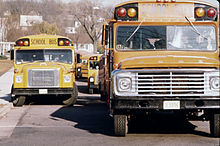 Two Type C buses from the "Big Six," photographed in the mid-1970s: A Ward (left) and a Wayne (right).
Two Type C buses from the "Big Six," photographed in the mid-1970s: A Ward (left) and a Wayne (right).
In 1980, there were six major school bus body manufacturers producing full-size school buses in North America:
- Blue Bird Body Company
- Carpenter Body Works
- Superior Coach Company
- Thomas Built Buses,Inc.
- Wayne Corporation
- Ward Body Works
The "Big Six" manufacturers produced bodies for chassis from three truck manufacturers (Ford, General Motors, and International Harvester) in addition to two coach-type school bus manufacturers who serviced the West Coast (Crown and Gillig).
Through the 1980s and 1990s, several manufacturers filed for bankruptcy or were purchased by other manufacturers. One of the few new firms that gained entry into the industry was Freightliner, who became a chassis supplier in the late 1990s. By 2005, only three of the original "Big Six" had survived (Blue Bird, Thomas, and IC Corporation—a rebranding of Ward successor AmTran).
Other changes
As a result of the 1970s fuel shortages, steps were also taken to improve the fuel economy of school buses. In the 1980s, manufacturers began to include diesel engines as options in conventional and small school buses; previously, diesel engines were considered a premium option only used on transit-style school buses. In 1986, Navistar International became the first chassis manufacturer to phase out gasoline engines entirely. Other manufacturers followed suit, and diesel engines replaced gasoline engines in virtually all full-size school buses by the mid-1990s.
Other changes involved making school buses easier to drive and operate for a wider variety of drivers. During the 1980s, automatic transmissions became commonly specified on school buses; this was most often the case for urban and suburban routes with stop-and-go driving. The issue of ergonomics led to increased attention towards the layout of controls and switches and how they were positioned. In addition to better ergonomics, many school bus manufacturers began to improve the safety of their school buses by increasing forward visibility for the driver. The demand for better forward visibility and better handling led to a major expansion of market share for transit-style school buses in the late 1980s and early 1990s. Initially, this was led by the Wayne Lifestar; the Blue Bird TC/2000 and Thomas Saf-T-Liner MVP would prove far more successful. In 1996, AmTran introduced the AmTran RE, the first low-cost rear-engine school bus.
After the closure of Carpenter in 2001, General Motors and Ford were gradually shut out of the full-size school bus industry. After building its last bus chassis in 1998, an agreement with Ford to supply Blue Bird with bus chassis fell through in 2002. General Motors, unable to find a body manufacturer to buy its chassis, produced its last full-size school bus chassis in 2003. Today, GM and Ford remain in the industry as the exclusive chassis suppliers for Type A school buses.
New-generation designs (2005-present)
The consolidation of school bus manufacturers of the 1980s and 1990s necessitated several different design changes throughout the industry. In the past, school bus manufacturers had been second-stage manufacturers; in nearly all cases, the buyer chose the chassis the body would be assembled on. The mergers and acquisitions of the past two decades had reduced the possible combinations of buses a manufacturer could build. Although choice was gone, this led to several product innovations previously not possible.
Full-size buses
In the past, conventional-style buses had been built on a chassis built from a separate manufacturer. In 2004, two school buses were introduced that led to buses being built from the ground up in-house. Blue Bird introduced the Vision conventional; in the same fashion of the All American, the chassis was designed by the company specifically for bus use and built in its own factory. Also in 2004, Thomas Built Buses introduced the Saf-T-Liner C2. Although bearing a strong visual resemblance to the Freightliner M2 Business Class, the C2's chassis was designed together with its body; as such, it could not be used by another body manufacturer.[citation needed]
In 2008, a redesigned Blue Bird All American was introduced as a 2010 model, showing the most extensive changes to the Blue Bird body design in over 45 years; similar changes have been made to other Blue Birds since then.
In November 2009, Starcraft Bus, a manufacturer of shuttle buses and Type A school buses, announced a joint venture with Hino Motors to produce full-size school buses, marking the first time since the 1990 departure of New Bus, Inc., that a body manufacturer has entered the full-size school bus market. The first prototype was scheduled to be shown in mid-2010.[18]
In June 2011, another school bus manufacturer was added to the mix: Lion Bus of Saint-Jérôme, Quebec was formed in partnership with Spartan Chassis, a division of Spartan Motors. The two companies executed a supply agreement to manufacture a new Type C school bus on June 16, 2011.[19] Lion Bus was co-founded by the former president and the former senior board adviser of Les Enterprises Michel Corbeil,[20] a former full-line school bus manufacturer whose manufacturing facilities were shut down after the company was acquired by Collins Industries in 2007.
Small buses
In the small school bus industry, the end of the 2000s was a period of major changes. As General Motors ended production of its P-chassis in the late 1990s, Type B school buses (already in decline) all but disappeared. Virtually all small school buses today are of Type A design; General Motors and Ford are the sole chassis producers.
Collins Bus Corporation, the largest independent manufacturer of Type A buses, purchased Canadian manufacturer Corbeil out of bankruptcy in 2007. Corbeil joined Ohio-based manufacturer Mid Bus as a Collins subsidiary; manufacturing of all three product lines was consolidated at the Kansas factory owned by Collins, leaving Girardin Minibus as the lone Canadian bus manufacturer. During the past decade, several smaller firms had gained entry into the industry with varying degrees of success. Of them, Starcraft Bus and Trans Tech are still in existence. In late 2009, Blue Bird Corporation and Girardin Minibus entered into a joint venture. In an effort to better focus on full-size bus design, Blue Bird discontinued its Type A product line (in production since 1975) in favor of Girardin-developed products built in Canada.[21] Today, Blue Bird Corporation manufactures full-size buses exclusively.
Other changes
The late 2000s have seen a variety of innovations introduced into school bus design; some changes are aimed at improving their environmental impact while others are intend to improve school bus safety. Several manufacturers have introduced hybrid school buses while alternatives to diesel fuel are also being explored. Seatbelts, always a controversial topic, have become more common in school buses; buses with 3-point seatbelts have been introduced. School bus crossing arms, first introduced in the late 1990s, have been adopted by a number of jurisdictions. Electronics have started to play a role in school bus operation. GPS tracking devices have been added to school buses in the past decade; this is used in a dual role of fleet management as well as a means of keeping parents updated. In addition, alarm systems have been developed to prevent children from being left on unattended school buses overnight.[22]
Manufacturing
For a more comprehensive list, see List of school bus manufacturers.In the current North American school bus industry, there are eight active manufacturers. Three of them—Collins Industries, Girardin, and Trans Tech—specialize in small buses, while two others—Blue Bird Corporation and Lion Bus—produce only full-size school buses. The remaining three companies—IC Bus, Starcraft Bus, and Thomas Built Buses—produce both small and large buses.
In most cases, school bus manufacturers work as second stage manufacturers. However, some school buses (typically those of Type D configuration) have both the body and chassis produced from a single manufacturer.
Of the manufacturers that no longer produce school buses, several are wholly defunct (Carpenter, Crown Coach, Wayne) while others have been absorbed into different manufacturers. IC Bus is the descendant of both AmTran and Ward; Collins owns and distributes Mid Bus and Corbeil products. Other manufacturers have moved into other enterprises; Gillig Corporation makes buses for mass-transit buyers, while Kenworth lives on as a manufacturer of Class 8 trucks.
Body configurations
The North American school bus industry produces buses in four different body configurations, listed alphabetically (along with trade name). All school buses in North America are of single deck design.
Type A ("cutaway van") school buses are the smallest type of school buses. They are also commonly referred to as "short buses". These buses are also the basis for the Multi-Function School Activity Buses (MFSAB) that are replacing 15-passenger vans as a means of transporting students in non-route service.[14]-
- Design characteristics[23]
- A bus body placed on a cutaway van chassis with a left-side driver's door.
- Single or dual rear wheels on drive axle.
- Capacities
- At least 10 passengers; typical passenger capacity ranges from 16-36 passengers.
- Type A buses are further classified into two sub-classes based on their gross vehicle weight rating (GVWR).
- Type A-1: GVWR of 14,500 pounds (6,600 kg) or less
- Type A-2: GVWR over 14,500 lb; A-2 buses typically use a medium-duty truck as a donor cab and chassis instead of a full-size van.
Type B ("integrated") school buses are larger and heavier than Type A school buses while still smaller than Type C/D buses. Type B buses are less commonly produced today than in the past.[14] IC BE is the only type B bus still produced from the competition between IC, Blue Bird Corporation, and Thomas Built Buses.-
- Design characteristics[23]
- A bus body mounted to either a stripped chassis.
- The entrance door is mounted behind the front wheels.
- In most versions (stripped-chassis models), the engine compartment is located partially inside the passenger compartment next to the driver.
- Capacities
- At least 10 passengers; typically between 30-36.
- Type B buses are further classified into sub-classes based on their GVWR.
- Type B-1: GVWR of 10,000 pounds or less
- Type B-2: GVWR over 10,000 lb
Type C ("conventional") school buses are the most common large school buses; as such, these have become the most synonymous with the depiction of large school bus in photography, film, and television.[14]-
- Design characteristics[23]
- A bus body mounted to a cowled medium-duty truck chassis (in the past, the chassis was often supplied from another manufacturer, but more recently, the chassis manufacturer and the bus body manufacturer are the same company).
- Although typically of cowled-chassis chassis design, a few Type C buses also are of cutaway-cab design.
- The entrance door is mounted behind the front wheels.
- The engine is mounted forward of the windshield
-
- Capacities
- Passengers: over 10, typically between 36-78.
- GVWR: over 21,500 pounds (9,800 kg), typically between 23,000–2,950 pounds (10,000–1,340 kg) .
Type D ("transit") school buses, as the trade name suggests, have origins in motorcoach and transit bus design. However, Type D buses are built to the same safety standards as any other school bus configuration.[14] Although their seating capacity does overlap with larger Type C buses, Type D buses are typically the largest school buses in use.-
- Design characteristics[23]
- A bus body mounted to a separate chassis.
- The entrance door mounted in front of the front wheels.
- Single rear axle or (very rarely) tandem rear axles
- The engine is mounted next to the driver inside the bus (front-engine/ "FE"), in the rear of the bus behind the rearmost seats (rear-engine/ "RE"), or in between the axles underneath the floor ("amidship" or "mid-engine")
- The last mid-engine Type D school buses were manufactured in 1991 when Crown Coach ceased operations.
- Capacities
- Passengers: over 10, typically between 54-90.
- GVWR: over 10,000 pounds (4,500 kg), typically between 25,000–36,000 pounds (11,000–16,000 kg).
In the United States, school buses are restricted to a maximum width of 102 in (2,590.80 mm); length is restricted to 45 ft (13.72 m).[24]
Other types of school buses
Activity bus
An "activity bus" is a school bus used for providing transportation for students. Instead of being used in route service (home to school), the intended usage of an activity bus is for transporting students for extracurricular activities. Depending on individual state and provincial regulations, the bus used for this purpose can either be a regular yellow school bus or a dedicated unit for this purpose. Dedicated activity buses, while not painted yellow, are fitted with the similar interiors as well as the same traffic control devices for dropping off students (at other schools).
Multi-function school activity bus (MFSAB)
In the past, groups that transport children and adults that did not need (or afford) a large bus commonly used 15-passenger vans to handle their transportation. However, such vehicles were at a disadvantage by comparison in terms of meeting safety regulations. To provide an alternative to 15-passenger vans (called "non-conforming vans" because they do not meet any safety standards for school buses),[25] manufacturers have designed buses that can replace 15-passenger vans. These are called Multi-Function School Activity Buses (MFSABs).
The basic design of MFSABs differs from yellow school buses because of their intended use. These differ from yellow school buses in that they are not intended for route service; therefore, they are not fitted with traffic control devices (red warning lights, stop arm).[26] Also, they are not painted school bus yellow. MFSAB buses are typically based on Type A school buses, although manufacturers offer MFSAB configurations for all four body styles of school buses.
If used by schools, MFSABs are primarily used for extracurricular activities requiring transportation; in the private sector, the MFSAB bus is commonly being purchased by child-care centers.
Canadian school buses
Canadian school buses are similar to their U.S. counterparts both in terms of overall design and their usage by school systems. The primary difference is the adaptation to Canada's bilingual population. In francophone Quebec, the signage on the outside of the bus is in French; the front and rear legends read ecoliers—French for "Schoolchildren"—and the stop signal arm legend may read arrêt, French for "Stop", though Canada Motor Vehicle Safety Standard 131 requires the legend to read stop.[27] Speedometers are calibrated in metric units and buses, like all other Canadian vehicles, are equipped with Daytime running lights. Buses are sometimes marketed differently, as well; the Blue Bird All American, for example, is rebadged as the Blue Bird TX3 in Canada and other export markets.
Canadian bus production
Along with the United States, Canada has its own history of school bus production. Along with Canada's two domestic firms (Corbeil and Girardin), several U.S. firms (Blue Bird, Thomas, Wayne) have located facilities in Canada in the past. Canadian-produced school buses are exported to the United States, and Canada imports many U.S.-produced buses. The Corbeil designs manufactured in Canada before the firm's 2008 closure are now manufactured and sold in the United States by current parent company Collins Industries. In Canada, Girardin Minibus manufactures Type A buses for the U.S. market branded as Blue Birds as part of a joint venture. In 2011, production of full-size school buses resumed in Canada as Lion Bus commenced production of Type C buses for both Canadian and U.S. operators.
School Buses in Mexico
In Mexico, in addition to yellow school buses seen from the United States, various other types of buses are used in the role of student transport. As in the United States, many schools own their own fleets of school buses; school bus yellow is not a government regulation, so most buses are painted in individual school colors. Depending on capacity needs, vans, minibuses, and midibuses are also used. Among retired American school buses, some newer ones are imported into Mexico and put back into school service.
- Role in Student Transport
Unlike the United States and Canada, school-owned buses are not primarily used for route service (due to high cost); instead, they are often used for field trips and other related excursions. In addition to students using regular transit systems, several Mexican companies specialize in scheduled student transportation.
Safety Regulations (North America)
Most of the changes made to the American school bus over the past 70 years have been safety-related, in response to progressively more stringent regulations. Along with federal mandates, advances in engineering have made school buses safer for drivers and passengers alike. Because of their size, school buses have many blind spots which can endanger passengers getting on or off the bus and people standing or walking nearby. This safety challenge is addressed through the design and configuration of a bus' windows, body panels, and mirrors. Controversy exists over the installation of seat belts as a restraint system for school bus passengers.
School bus yellow
A 1939 school bus seen in a museum display. Its orange color predates the adoption of school bus yellow.
Yellow was adopted as a standard color for North American school buses beginning in 1939. In April of that year, Dr. Frank W. Cyr, a professor at Teachers College at Columbia University in New York organized a meeting to establish national school bus construction standards, including yellow body paint. It became known officially as "National School Bus Chrome", later renamed "National School Bus Glossy Yellow." The color, which has come to be frequently called simply "school bus yellow", was selected because black lettering on that specific hue was easiest to see in the semi-darkness of early morning and late afternoon.
The conference met for seven days and the attendees created a total of 45 standards, including specifications regarding body length, ceiling height, and aisle width. Dr. Cyr's conference, funded by a $5,000 grant from the Rockefeller Foundation, was also a landmark event inasmuch as it included transportation officials from all 48 states (at the time), as well as specialists from school bus manufacturing and paint companies. The conference approach to school bus safety, as well as the yellow color, has endured into the 21st century.
Traffic priority
By the mid 1940s, most states had traffic laws requiring motorists to stop for school buses while children were loading or unloading.[citation needed] The justifications for this protocol are:
-
- Children, especially the younger ones, have normally not yet developed the mental capacity to fully comprehend the hazards and consequences of street-crossing, and under U.S. tort laws, a child cannot legally be held accountable for negligence. For the same reason, adult crossing guards often are deployed in walking zones between homes and schools.
-
- It is impractical in many cases to avoid children crossing the traveled portions of roadways after leaving a school bus or to have an adult accompany them.
-
- The size of a school bus generally limits visibility for both the children and motorists during loading and unloading.
Since at least the mid 1970s, all U.S. states and Canadian provinces and territories have some sort of school bus traffic stop law; although each jurisdiction requires traffic to stop for a school bus loading and unloading passengers, different jurisdictions have different requirements of when to stop. Outside of North America, the school bus stopping traffic to unload and load children is not provided for. Instead of being given traffic priority, fellow drivers are encouraged to drive with extra caution around school buses.
Safety devices
Warning lights
Around 1946, the first system of traffic warning signal lights on school buses was used in Virginia. This system comprised a pair of sealed beam lights similar to those employed in American headlamps of the time. Instead of colorless glass lenses, the warning lights utilized red lenses. A motorized rotary switch applied power alternately to the red lights mounted at the left and right of the front and rear of the bus, creating a wig-wag effect. Activation was typically through a mechanical switch attached to the door control. However, on some buses (such as Gillig's Transit Coach models and the Kenworth-Pacific School Coach) activation of the roof warning lamp system was through the use of a pressure sensitive switch on a manually-controlled stop paddle lever located to the left of the driver's seat below the window. Whenever the pressure was relieved by extending the stop paddle, the electrical current was activated to the relay.
In later years, electromechanical wig-wag flasher controls were replaced by electronic ones, and the warning lights were increased from four — two front and two rear, all red — to eight — two amber to warn of an impending stop, and two red to indicate a stop in progress, front and rear. Some jurisdictions, such as Wisconsin and Ontario, Canada still do not permit the amber-and-red system; all-red warning systems are still used in such locales. Newer buses with provisions for the amber-and-red eight-lamp system generally use eight red lenses where amber is not permitted. Plastic lenses were developed in the 1950s, though sealed beams — now with colorless glass lenses — were still most commonly used behind them until the mid 2000s, when light-emitting diodes (LEDs) began supplanting the sealed beams.
Stop signal arm
During the early 1950s, states began to specify a mechanical stop signal arm which the driver would swing out from the left side of the bus to warn traffic of a stop in progress. The portion of the stop arm protruding in front of traffic was initially a rectangle with stop painted on it. The U.S. National Highway Traffic Safety Administration's Federal Motor Vehicle Safety Standard]] No. 131 regulates the specifications of the stop arm as a double-faced regulation octagonal red stop sign at least 45 cm (17.7 in) across, with white border and uppercase legend. It must be retroreflective and/or equipped with alternately-flashing red lights. As an alternative, the stop legend itself may also flash; this is commonly achieved with red LEDs.[28] FMVSS 131 stipulates that the stop signal arm be installed on the left side of the bus, and placed such that when it is extended, the arm is perpendicular to the side of the bus, with the top edge of the sign parallel to and within 6 inches (15 cm) of a horizontal plane tangent to the bottom edge of the first passenger window frame behind the driver's window, and that the vertical center of the stop signal arm must be no more than 9 inches (23 cm) from the side of the bus. One stop signal arm is required; a second may also be installed.[28] The second stop arm, when it is present, is usually mounted near the rear of the bus, and is not permitted to bear a stop or any other legend on the side facing forward when deployed.[28]
The Canadian standard defined in Canada Motor Vehicle Safety Standard No. 131, is substantially identical to the U.S. standard.[27]
Emergency exits
In addition to the entry door, all school buses have at least one emergency exit door (in rear-engine buses, a window exit) in the rear of the bus. The rear door was a feature retained from when school buses were horse-drawn wagons and the entrance door was rear-mounted to avoid frightening the horses.
Additional exits may be located in the roof (roof hatches), window exits, and/or side emergency exit doors. All are opened by the use of quick-release latches which activate an alarm. The number of emergency exits in a school bus depends on the size of the bus(its seating capacity) along with individual state regulations.
Retroreflective markings
Building on the longstanding requirement for school bus yellow, many North American states and provinces — Colorado, for example[29] — call for school bus yellow retroreflective conspicuity tape on the sides and rear of buses to mark their length, width, and height. This makes it easier in darkness or poor weather for other drivers to see the bus by the light of their headlamps and correctly perceive its size and position. Federal Motor Vehicle Safety Standard 217 also requires that yellow, white, or red retroreflective be applied so as to mark all emergency exits, so rescue personnel can quickly find them in darkness.[30] Canada's equivalent is almost identical, the only difference is red cannot be used as a retroreflective color.
Other safety devices
Some states such as Illinois,[31] as well as some school districts and bus operators also call for strobe lights on the roof of the bus.
During the past decade, video cameras have become common equipment installed inside school buses, primarily to monitor and record passengers' behavior. Video cameras have also been useful in determining the causes of accidents: on March 28, 2000, a Murray County, Georgia, school bus was hit by a CSX freight train at an unsignalled railroad crossing. Three children were killed. The bus driver claimed to have stopped and looked for approaching trains before proceeding across the tracks, as is required by law, but the onboard camera recorded that the bus had in fact not stopped.[32]
Structural integrity
As the school bus evolved as a specialized vehicle in the United States and Canada, concerns arose for the protection of passengers in major traffic collisions. A particular structural weak point in catastrophic school bus crashes was the joints where panels and pieces were fastened together.
Longitudinal steel guard rails had been in use since the 1930s to protect the sides of buses, but behind them on the sides and on the roofs, by the 1960s, all manufacturers were combining many individual steel panels to construct a bus body. These were usually attached by rivets or similar fasteners such as huckbolts.
In the mid 1960s, Ward Body Works of Conway, Arkansas, subjected one of their school bus bodies to multiple rollovers, and noted separation at the panel joints, as well as pointing out that many of their competitors were using relatively few rivets. This resulted in new attention by all the body companies to the number and quality of fasteners. Wayne Corporation's crash tests showed the joints to be points of weakness no matter how many fasteners were used, and in 1973 the company began building "Lifeguard" buses with single longitudinal interior and exterior panels for the sides and roof. Eliminating the joints reduced the number of points for potential body separation in a catastrophic impact.
The unit-panel construction reduced body weight, fastener count, and assembly time. However, it required very large roll-form presses and special equipment to handle the enormous panels. In addition, the panels had to be cut to exact length for each bus body order, which varied with the intended seating capacity and order specifications. This created a marketing disadvantage as the Wayne Lifeguard buses required greater manufacturing lead time than bus bodies made up of riveted smaller panels.
1977 safety standards
The focus on structural integrity spurred new requirements in the U.S. Federal Motor Vehicle Safety Standards for school buses, most of which became applicable for school buses on April 1, 1977. These standards are still in effect today.
Standard No. 217 - Bus Emergency Exits and Window Retention and Release (Effective September 1, 1973)
- This established requirements for bus window retention and release to reduce the likelihood of passenger ejection in crashes, and for emergency exits to facilitate passenger exit in emergencies. It also requires that each school bus have an interlock system to prevent the engine starting if an emergency door is locked, and an alarm that sounds if an emergency door is not fully closed while the engine is running.
Standard No. 220 - School Bus Rollover Protection (Effective April 1, 1977)
- This established performance requirements for school bus rollover protection, to reduce deaths and injuries from failure of a school bus body structure to withstand forces encountered in rollover crashes.
Standard No. 221 - School Bus Body Joint Strength (Effective April 1, 1977)
- This established requirements for the strength of the body panel joints in school bus bodies, to reduce deaths and injuries resulting from structural collapse of school bus bodies during crashes.
Standard No. 222 - School Bus Passenger Seating and Crash Protection (Effective April 1, 1977)
- This established occupant protection requirements for school bus passenger seating and restraining barriers, to reduce deaths and injuries from the impact of school bus occupants against structures within the vehicle during crashes and sudden driving maneuvers.
Standard No. 301 - Fuel System Integrity - School Buses (Effective April 1, 1977)
- This specified requirements for the integrity of motor vehicle fuel systems, to reduce the likelihood of fuel spillage and resultant fires during and after crashes.
These new federal standards brought significant change to the design, engineering, and construction of school buses and a substantial improvement in safety performance. Further improvement has resulted from continuing efforts by the U.S. National Highway Traffic Safety Administration (NHTSA) and Transport Canada, as well as by the bus industry and various safety advocates.
Blind zones
School Bus Blind Zones
School buses are equipped with safety devices to protect pedestrians around the blind spots of a parked bus.In the United States, approximately ⅔ of students killed outside a school bus are not struck by other vehicles, but by their own bus.[33]
To reduce the driver's blind zones, more sophisticated and comprehensive mirror systems have been developed. As Type C and D buses have been redesigned and updated, windshields have been significantly enlarged in size to remove obstacles from the driver's lines of sight.
To prevent pedestrians walking so close to the front of the bus that the hood obscures them from the driver's view, North Carolina is one of several states that requires school buses to be equipped with crossing arms which extend from the front bumper while the bus is stopped for loading or unloading.[34] These force passengers to walk several feet forward of the bus before they can begin to cross the road in front of it.
Another hazardous area is at the loading door; a drawstring or loose clothing may catch on something as a student gets off. If the driver is unaware, the student may still be attached to the outside of the bus as it begins to pull away. To reduce this risk, school bus manufacturers have redesigned handrails and equipment in the stepwell area. In its School Bus Handrail Handbook, the NHTSA described a simple test procedure for identifying unsafe stepwell handrails.[35]
Restraints and seating
Seat belts
In contrast to cars and other light duty passenger vehicles, school buses typically are not equipped with seat belts. In 1977, as provided in Federal Motor Vehicle Standard 222, the U.S. federal government required passive restraint and more stringent structural integrity standards for school buses instead of requiring lap seat belts. The passive restraint standards exempted school buses with a gross vehicle weight (GVWR) of over 10,000 pounds from requiring seat belts. A revised FMVSS 222 was set to take effect in October 2011 to require three-point, lap/shoulder belts in all newly-manufactured Type A small school buses to improve occupant protection. The revised standard also introduces standards for testing lap/shoulder belt-equipped bus seats and the anchor points for the optional installation of these seat-belt systems in large school buses. The new FMVSS 222 seat-belt equipped seats that at one time could reduce passenger capacity by up to one-third. But NHTSA recognized new technology currently on the market and in use at school districts like in Buffalo, N.Y., that relies on the flexibility of belting either three smaller children or two larger children per seat. [36].[37]
Whether seatbelts should be a requirement remains controversial;[38] currently, they are a requirement in at least five states[39]:
- Florida
- Louisiana
- New Jersey (see below)
- New York
- California
- Texas
Of the states that equip buses with two-point, lap seat belts (Florida, Louisiana, New Jersey and New York), New Jersey requires seat belt usage by riders.[40] In other states, it is up to the district whether to require riders to use them or not.
In July 2004, California became the first state to require three-point, lap/shoulder seat belts on all new Type A small school buses. A year later, this requirement was extended to large Type C and Type D school buses. Texas followed with its own three-point seat belt law for school buses in 2007 with a 2010 implementation date, if funding was available. So far, the Texas Education Agency has only received $2.6 million for optional grants. [41].
Compartmentalization
As a concept, compartmentalization was introduced in 1967 by safety researchers at UCLA. The premise behind compartmentalization is that improved seat design with high-back padded seats spaced close together (a maximum of 24 inches (61 cm) apart front to back) would better contain passengers in the event of a crash. Although not an element of compartmentalization, the UCLA researchers who conducted the 1967 tests on school buses concluded that after high back seats, next in importance to school bus passenger collision safety is the use of a three-point belt, a lap belt or other form of effective restraint. In April 1977, Federal Motor Vehicle Standard 222 changed the design of school bus seats from low metal-backed seats to the thickly-padded seats still in use today.[37]
Environmental compatibility
In theory, school buses reduce pollution in the same manner that carpooling does but on a much larger scale; a single school bus can take take as many as 90 cars off the road at one time. However, buses are not a completely pollution-free method like biking or walking. Some of the drawbacks involved stem from the idling of buses while waiting for students to be unloaded and loaded at bus stops and at school. Since most school buses use diesel fuel, people standing or walking near the bus are exposed to exhaust fumes, which are believed to lead to health problems. Some older buses have been retrofitted with upgraded emission controls and diesel particulate filters,[42] and new buses meet more rigorous emissions standards with more advanced engines and emission control strategies such as Selective catalytic reduction; a bus meeting 2007-model year emissions standards is 60 times cleaner than a bus from 1990.[42]
Alternative fuels
Although diesel fuel is most commonly used in large school buses (and even in many smaller ones), alternatives such as propane, CNG, and hydrogen have been developed to counter the drawbacks that diesel and gasoline-fueled school buses pose to the environment.
-
- Propane
- In the 1970s and 1980s, as a response to the gas crisis, propane conversions of gasoline engines were made available (most commonly those used in the General Motors B-Series). These conversions fell out of favor due to declining fuel prices and the increasing usage of diesel engines. Currently, Blue Bird Corporation offers a propane-powered option in its conventional Vision model bus.[43]
-
- Compressed natural gas (CNG)
- Compressed natural gas school buses were introduced by Blue Bird in 1991, using the Cummins ISL-G engine in its Type D All American rear engine body and chassis.[43] CNG is also available as an option from Thomas Built Buses on the Saf-T-Liner HDX.[44]
-
- Methanol
- Another conversion of existing engine architecture involved the use of methanol as a fuel source. In 1989, Crown Coach introduced the Supercoach Series II, a bus with a Detroit Diesel 6V92 converted to run on methanol instead of diesel. The same powertrain was offered into the 1990s by Carpenter on their Coach RE transit-style bus, but few were sold, and many methanol-fueled engines were later converted to diesel by their operators.
Diesel-electric and gas-electric hybrids
IC Bus, in collaboration with Enova Systems, unveiled the nation's first hybrid electric school bus in 2006 at the New York Association of Pupil Transportation (NYAPT) Show. This plug-in hybrid-electric vehicle (PHEV) school bus is claimed to reduce fuel consumption by as much as 40 percent compared to ordinary diesel buses.
Eleven states joined together for an exploratory purchase of 19 school buses from IC Bus. New York, California, Texas, Florida, Pennsylvania, Virginia, North Carolina, South Carolina, Arkansas, Iowa and Washington will be the first states in the nation to receive these diesel electric hybrid school buses.[citation needed] Since then, hybrids have slowly begun to gain acceptance in the marketplace nationwide as the incremental cost of these vehicles comes down. Hybrids generally cost about $200,000 as of spring 2011, compared to more than $100,000 for a regular-sized diesel school bus.[45]
In 2009, Collins Bus announced the NexBus, the industry's first hybrid electric Type A school bus. The NexBus uses a Ford E-450 chassis with technology from Azure Dynamics Corporation.[46]
Retirement
Removal from front-line service
After a school bus has been withdrawn from regular day-to-day service, it may be used as a substitute for newer buses for any one of a number of reasons, usually while a newer bus is being serviced or needs maintenance, or a regular bus is unavailable (in use for another duty, such as transporting athletes to an event). The older buses are still maintained to comply with all applicable safety standards, but sometimes lack features of newer buses, such as air conditioning, radios and tinted windows.
A bus is often completely retired from school service when it becomes no longer cost-effective to keep it in reliable and safe condition. Some transportation services may have a vehicle replacement schedule calling for a bus to be replaced after at a specific age, even if the vehicle is in good or excellent condition. Many of these retired school buses are sold to such entities as churches, resorts or camps.
Buses converted to non-school use are prohibited by federal safety standards from displaying the "School Bus" lettering. Stop arms and signal lamps must be disabled or removed.[2]
Other uses
- Conversion and restoration
Some retired school buses are converted to recreational vehicles (RVs); enthusiasts of this type of vehicle conversion are sometimes called Skoolies. Other retired buses are purchased by enthusiasts or collectors for restoration to as-new condition in the same fashion of any other older vehicle.
Former school buses may also be converted into farm utility vehicles for cattle feeding, fruit orchard maintenance and harvest, and other tasks. Most of the roof and body sides are removed, leaving only a cab for the driver enclosed with a rear wall. This creates a truck with an extremely long, flat bed. Many farms also use unconverted school buses (with usually just the name of the school district it once served and the "School Bus" lettering on the front and back blacked out) to transport their migrant workforce.
- Export
Some retired school buses are exported to Latin America, Africa, or elsewhere. They are used as school buses, municipal transport, or for the transport of migrant farmworkers. Once they are exported, their new owners often update the color scheme from school bus yellow to a variety of different colors.
- Motorsport
Retired school buses are sometimes entered in special demolition derby or figure 8 racing events. Examples of speedways that prominently feature school bus demolition derbies include Waterford Speedbowl in Waterford, Connecticut and Little Valley Speedway.
Safety issues
Since school buses sold upon their retirement are typically older models, they do not offer occupants the same level of safety performance as newly-produced buses. This relative lack of safety performance was scrutinized after the 1988 Carrollton, Kentucky bus collision. The collision involved a church bus which had been originally built and served as a school bus; it resulted in one of the deadliest bus accidents in United States history. In addition to extensive media coverage and considerable litigation, an investigation was launched by the National Transportation Safety Board (NTSB). Subsequently, many federal, state, and local agencies and bus manufacturers changed regulations, vehicle features, and operating practices.
While pre-1977 school buses have largely been phased out of use (in most states), buses from before 1977 can sometimes be found carrying passengers as church buses. In most cases, these are bound by fewer regulations than school buses. Alabama, Arkansas, Kentucky, Tennessee, and Virginia[47] are the only American states where school bus stop laws are similarly applied to church buses, if equipped with the flashing red lights used on school buses and operated in compliance with the same regulations as school buses. Other states may have vehicles marked as "church" buses, but they do not have church bus stop laws similar to school bus stop laws.
Design (outside North America)
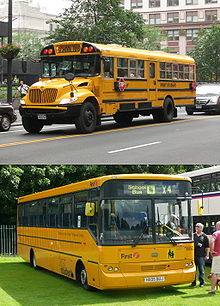 School bus design compared: A typical North American school bus (top) and a typical school bus from the UK. (bottom) Both buses are operated by First Student.
School bus design compared: A typical North American school bus (top) and a typical school bus from the UK. (bottom) Both buses are operated by First Student.
Outside of North America, the yellow school bus is not as common; buses used for the purpose of student transport are typically closer in design to mass-transit buses. These buses may be painted yellow or other similar shades, but school bus yellow is not a government specification like it is on school buses from the United States or Canada and so is generally seen only on buses imported from North America. School buses outside of North America typically do not have traffic priority while loading or unloading students; school bus traffic stop laws differ from North American counterparts (if they exist at all).
Australia
In Australia all school buses are white and appear exactly the same as public buses.[citation needed] Some private schools own their own bus fleet, for example a regional private school may own up to 20 buses.
China
Chinese bus manufacturer Zhengzhou Yutong Group Co., Ltd., is manufacturing a school bus model, the ZK6100DA, to schools in China. It was described as a "big-nose school bus" with a "classic western-style appearance" by one online newspaper.[48]
Hong Kong
In Hong Kong, younger students are transported between their homes and schools by "nanny vans". These vehicles are typically van-based and are smaller than a minibus. When nanny vans originated, they were regulated primarily by the schools and the van drivers. Today, in the interest of safety, nanny vans are government-regulated vehicles that run on fixed routes.
United Kingdom
In the United Kingdom, student transport by bus is typically handled with the use of local scheduled public transport bus services. Bus services for school students are usually contracted out to local bus companies, using ordinary buses which are used for other purposes when not in use for school journeys.
- Dedicated school buses in the UK
To encourage students to travel to school by bus (as opposed to by car), North American-style yellow school buses were introduced under the First Student UK program starting in 2000. The first buses were sourced from the United States, but subsequently, newer, more conventional UK bus shapes have been locally produced.
A project in West Yorkshire by public transport agency West Yorkshire Metro to provide higher-quality, dedicated yellow school buses with coordinated Mybus branding gained significant mode shift: 64% of primary school users were previously driven by car. Under this scheme, these buses were not allowed to be used for non-school purposes.[49]
Operating out of Birmingham, England is the school bus operator The Green Transport Company Limited, using the brand name The Green Bus. As the name suggests, the company's buses are distinguished by their green livery instead of the traditional yellow. The Green Bus transports children to and from grammar schools in the city.
See also
- List of school bus manufacturers
- Desegregation busing in the United States
- Walking bus
References
- ^ Peter Daniels. "Stoke Newington Quakers - Early History." Retrieved 2010-04-05
- ^ a b c Highway Safety Program Guidelines: Pupil Transportation Safety. National Highway Traffic Safety Administration website. Retrieved 2010-06-23.
- ^ "FAQs". American School Bus Council. http://www.americanschoolbuscouncil.org/index.php?page=faq#a_5. Retrieved 2010-11-27.
- ^ a b c Mark Theobald (2004). Wayne Works. Coachbuilt.com. Retrieved 2010-04-26
- ^ a b The Gillig Story The Gillig Transit Coach and Pacific Schoolcoach Online Museum. (See "Gillig Bros. - the Early Years"). Retrieved 2010-04-07
- ^ Mark Theobald (2004). "Crown Coach". Coachbuild.com. Retrieved 2010-04-29
- ^ J. H. Valentine. "Crown Coach: California's Specialty Builder". Tripod. http://buskidspage.tripod/jimvalentine.htm. Retrieved 2010-04-27.
- ^ a b c d Sandi Brockway (January 11, 2007). "Crown Coach Corporation (1932-1991)". Crown Coach Historical Society. Retrieved 2010-04-28
- ^ a b "Frank W. Cyr, 'Father of the Yellow School Bus,' Dies at the Age of 95". Columbia University press release (August 3, 1995). Retrieved 2010-04-07
- ^ http://www.e-laws.gov.on.ca/html/statutes/english/elaws_statutes_90h08_e.htm#BK259
- ^ Rob Watson (June 13, 2000). "UK may get yellow school buses". BBC News. http://news.bbc.co.uk/2/hi/americas/784567.stm. Retrieved 2010-04-07.
- ^ "The War, and becoming an industry leader". GilligCoaches.net. Retrieved 2010-06-15
- ^ "Collins Bus Corporation". http://www.collinsbus.com. Retrieved 2010-02-15. Corporate webpage with minor history
- ^ a b c d e "School Bus types". School Transportation News. http://www.stnonline.com/faqs. Retrieved January 3, 2010.
- ^ Urban Dictionary: short bus
- ^ "Federal Motor Vehicle Safety Standards". School Transportation News. Aug. 8, 2009. http://www.stnonline.com/resources/government/federal-motor-vehicle-safety-standards. Retrieved 2011-06-02.
- ^ "Report to Congress: School Bus Safety Crashworthiness Research". NHTSA. April 2002. http://www.nhtsa.gov/DOT/NHTSA/NRD/Multimedia/PDFs/Crashworthiness/SchoolBus/SBReportFINAL.pdf. Retrieved 2011-06-02.
- ^ Ryan Gray (6 November 2009). "Starcraft, Hino Trucks to Partner on Type C School Bus". School Transportation News. STN Media Group. http://stnonline.com/home/top-stories/1435-starcraft-hino-trucks-to-partner-on-type-c-school-bus. Retrieved 9 November 2009.
- ^ "Spartan Chassis Executes Agreement With Lion Bus Inc. for Type C School Bus Chassis". MarketWatch. 16 June 2011. http://www.marketwatch.com/story/spartan-chassis-executes-agreement-with-lion-bus-inc-for-type-c-school-bus-chassis-2011-06-16?reflink=MW_news_stmp. Retrieved 17 June 2011.
- ^ "Team". Lion Bus. http://www.lionbuses.com/en/team. Retrieved 17 June 2011.
- ^ "Blue Bird, Girardin Join Forces". School Bus Fleet Magazine. February 19, 2010. http://www.schoolbusfleet.com/Channel/Management-Training/Articles/2010/02/Q-A-Blue-Bird-Girardin-Join-Forces.aspx. Retrieved 2010-04-14.
- ^ "FAQs/Q: The school bus looks like it’s hardly changed in decades. Where’s the modernization". American School Bus Council. http://www.americanschoolbuscouncil.org/index.php?page=faq#s_3. Retrieved 2010-12-03.
- ^ a b c d National School Bus Congress Pg. 7
- ^ "NATIONAL SCHOOL TRANSPORTATION SPECIFICATIONS and PROCEDURES (2005 Revised Edition)". p. 40. http://www.ucmo.edu/safetycenter/ncstonline/Documents/2005%20NSTSP-v4-4-7-08.pdf. Retrieved 2011-01-10.
- ^ "Are there other vehicles that can be used for school transportation? Vans?". http://www.stnonline.com/faqs. Retrieved 2010-05-23.
- ^ "Why do some school buses look different than others, for example in color?". http://www.stnonline.com/faqs. Retrieved 2010-05-23.
- ^ a b Canada Motor Vehicle Safety Standard - Technical Standards Document 131
- ^ a b c School bus pedestrian safety standards Code of Federal Regulations Title 49, Section 571.131. Retrieved 2010-4-15.
- ^ Colorado Minimum Standards Governing School Bus Transportation Vehicles Colorado Code of Regulations 301-25, Section 2251-R-54.02. Retrieved 2010-04-16
- ^ Bus emergency exits and window retention and release Code of Federal Regulations Title 49, Section 571.217. Retrieved 2010-04-15
- ^ Illinois school bus safety standards: Lamps, Reflectors, Signals Illinois Administrative Code Title 92 (Transportation), Sec. 442.615g. Retrieved 2010-04-16
- ^ Highway Accident Report - NTSB/HAR-01/03 National Transportation Safety Board (December 11, 2001). Retrieved 2010-04-16
- ^ "Protecting Children from Their Own Buses by Mark D. Fisher". http://autos.groups.yahoo.com/group/WayneBusEnthusiasts/files/. Retrieved January 29, 2006.
- ^ Improving Safety in the Danger Zone School Bus Fleet (September 1, 2007). Retrieved 2010-04-19
- ^ Handrail Mechanics School Bus Handrail Handbook. National Highway Traffic Safety Administration. Retrieved 2010-04-19.
- ^ Ryan Gray (August 7, 2009). [School Bus Seat Belts "School Bus Seat Belts FAQ"]. School Transportation News. School Bus Seat Belts. Retrieved 2011-06-02.
- ^ a b "School Bus Seat Belts". School Transportation News. http://www.stnonline.com/faqs. Retrieved 2010-04-16.
- ^ Janna Morrison (August 8, 2008). "NAPT Advocates Scientific Approach to Seat Belt Issue". School Transportation News. http://www.stnonline.com/resources/seat-belts/related-seat-belt-articles/264-napt-advocates-scientific-approach-to-seat-belt-issue. Retrieved 2010-04-16.
- ^ Susan Haigh (February 17, 2010). "Connecticut considers installing seat belts on school buses". The Hour Online. http://www.thehour.com/story/482394. Retrieved 2010-04-16.
- ^ Seat Belts in School Buses Transport Canada. Retrieved 2010-04-19
- ^ Ryan Gray (July 8, 2009). "The History of Seat Belt Development". School Transportation News. http://www.stnonline.com/resources/seat-belts/the-history-of-seat-belt-development. Retrieved 2011-06-02.
- ^ a b "FAQs/Q: Is it healthy for my child to ride the school bus?". American School Bus Council. http://www.americanschoolbuscouncil.org/index.php?page=faq#s_8. Retrieved 2010-12-03.
- ^ a b Blue Bird's Alternative Fuel Product Offerings Blue Bird Corporation. Retrieved 2010-4-16
- ^ Saf-T-Liner HDX Thomas Built Buses (pdf brochure). Retrieved 2010-04-16
- ^ http://www.stnonline.com/blogs/school-bus-bay/3172-hybrid-transit-and-school-buses
- ^ Collins Hybrid Collins Bus Corp. Retrieved 2010-04-16
- ^ "LIS § 46.2-917.1. School buses hired to transport children.". Code of Virginia. http://leg1.state.va.us/cgi-bin/legp504.exe?000+cod+46.2-917.1. Retrieved December 4, 2005.
- ^ "Bigger nose means bigger safety for Qingdao school buses". chinadaily.com.cn. 06 June 2011. http://www.chinadaily.com.cn/m/shandong/e/2011-06/08/content_12655152.htm. Retrieved 18 June 2011.
- ^ Executive Summary – Mybus report. West Yorkshire Integrated Transport Authority. Retrieved 2009-10-09
External links
- School Bus Fleet Magazine - news magazine for student transportation professionals
- School Transportation News - news magazine for student transportation professionals
- U.S. DOT, NHTSA, Federal Motor Vehicle Safety Standards for School Buses (FMVSS)
Collins Industries (Collins, Mid Bus, Corbeil)
Girardin Minibus
Starcraft Bus
Trans TechDefunct Manufacturers (Including date of closure or last school bus manufacture)2000sCarpenter Industries, Inc (2001) • American Transportation Corporation (AmTran) (2002; became IC Bus) • Les Enterprises Michel Corbeil (2008; acquired by Collins) • Liberty Bus (2005) • U.S. Bus Corporation1990sCoach and Equipment Manufacturing (1999; still in business) • Crown Coach Corporation (1991) • Gillig Corporation (1993; still in business) • Mid Bus (1998; acquired by Collins) • TAM-USA (1991) • Wayne Corporation (1992; became Wayne Wheeled Vehicles) • Wayne Wheeled Vehicles (1995)1980s1970s1960s1950sList of school bus manufacturersNorth American bus builders Active Eagle Bus
ElDorado National
Federal Coach
Ford Motor Company
Glaval Bus
Gillig Corporation
Girardin Minibus
Goshen CoachPrevost Car
Setra
Stallion Bus Industries
Starcraft Bus
Thomas Built Buses
Trans Tech
Trident Bus IndustriesDefunct ACF-Brill
Aerocoach
AM General
AmTran
Beck
Canadian Car and Foundry
Carpenter Body Company
Corbeil Bus CorporationCrown Coach Corporation
Fageol
Fifth Avenue Bus Company
FitzJohn
Flxible
General Motors Corporation/
General Motors Diesel Division (GM Coach)
KenworthLAG Motorcoach
Mack Trucks
MASA
National Coach Corp.
Neoplan USA
Superior Coach Company
Transportation Manufacturing CorporationTwin Coach
U.S. Bus Corporation
Ward Body Works
Wayne Corporation
Wayne Wheeled Vehicles
White Motor Company
Yellow CoachBuses Configuration List of buses · Articulated bus · Bi-articulated bus · Coach · Double-decker bus · High-floor · Lowbridge double-deck bus · Low-floor bus · Midibus · Minibus · Multi-axle bus · Open-top bus · Single-decker bus · Trailer bus · Truck busSpecial uses Advert bus · Airport bus · Armoured bus · Battle bus · Campaign bus · Party bus · Police bus · School bus · Sleeper bus · Transit bus · Training bus · Tour bus · Trolley-replica busTechnologies Manufacturing Bus manufacturing · Bus manufacturersCategories:- Types of buses
- School buses
- Student transport
Wikimedia Foundation. 2010.

